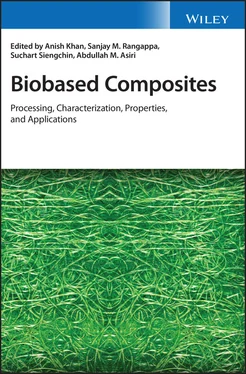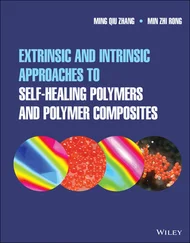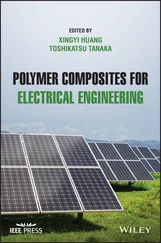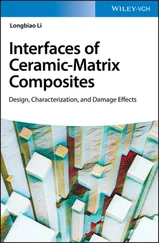Biobased Composites
Здесь есть возможность читать онлайн «Biobased Composites» — ознакомительный отрывок электронной книги совершенно бесплатно, а после прочтения отрывка купить полную версию. В некоторых случаях можно слушать аудио, скачать через торрент в формате fb2 и присутствует краткое содержание. Жанр: unrecognised, на английском языке. Описание произведения, (предисловие) а так же отзывы посетителей доступны на портале библиотеки ЛибКат.
- Название:Biobased Composites
- Автор:
- Жанр:
- Год:неизвестен
- ISBN:нет данных
- Рейтинг книги:4 / 5. Голосов: 1
-
Избранное:Добавить в избранное
- Отзывы:
-
Ваша оценка:
- 80
- 1
- 2
- 3
- 4
- 5
Biobased Composites: краткое содержание, описание и аннотация
Предлагаем к чтению аннотацию, описание, краткое содержание или предисловие (зависит от того, что написал сам автор книги «Biobased Composites»). Если вы не нашли необходимую информацию о книге — напишите в комментариях, мы постараемся отыскать её.
Biobased Composites: Processing, Characterization, Properties, and Applications
Biobased Composites
Biobased Composites — читать онлайн ознакомительный отрывок
Ниже представлен текст книги, разбитый по страницам. Система сохранения места последней прочитанной страницы, позволяет с удобством читать онлайн бесплатно книгу «Biobased Composites», без необходимости каждый раз заново искать на чём Вы остановились. Поставьте закладку, и сможете в любой момент перейти на страницу, на которой закончили чтение.
Интервал:
Закладка:
Table of Contents
1 Cover
2 Title Page Biobased Composites Processing, Characterization, Properties, and Applications First Edition Anish Khan King Abdulaziz University, Jeddah, Saudi Arabia Sanjay M. Rangappa King Mongkut’s University of Technology North Bangkok, Bangkok, Thailand Suchart Siengchin King Mongkut's University of Technology North Bangkok, Bangkok, Thailand Abdullah M. Asiri King Abdulaziz University, Jeddah, Saudi Arabia
3 Copyright Page
4 List of Contributors
5 Preface
6 1 Introduction to Biobased Composites 1.1 Introduction 1.2 Biodegradable Materials 1.3 Polymers in Tissue Engineering 1.4 Environmental Realization 1.5 Biomass Composites Characteristics and Testing 1.6 Life‐cycle Assessment 1.7 Conclusions References
7 2 Processing Methods for Manufacture of Biobased Composites 2.1 Introduction 2.2 Biobased Materials 2.3 Processing Methods 2.4 Fabrication Techniques of Biobased Composites 2.5 Fillers and Reinforcements Used in the Preparation of Biobased Composites 2.6 Conclusion References
8 3 Physicochemical Analysis of Biobased Composites 3.1 Introduction 3.2 Performance of Biocomposites 3.3 Physicochemical Properties 3.4 Conclusion References
9 4 Characterization of Biobased Composites 4.1 Introduction 4.2 The Conception of Composites 4.3 Classification of Biocomposites 4.4 Materials for the Synthesis of Biobased Composites 4.5 Challenges of the Introduction of Natural Fiber References
10 5 Mechanical, Thermal, Tribological, and Dielectric Properties of Biobased Composites 5.1 Introduction 5.2 Characterization of Biobased Composites 5.3 Factors Influencing Various Properties of the Biobased Composites 5.4 Mechanical Properties of Biobased Composites 5.5 Thermal Properties of Biobased Composites 5.6 Tribological Properties of Biobased Composites 5.7 Dielectric Properties of Biobased Composites 5.8 Conclusions References
11 6 Flame Retardancy of Biobased Composites 6.1 Introduction 6.2 Types of Biobased Polymer Composites Used in a Flame‐Retardant Application 6.3 Role and Effect of Natural Byproducts on the Flame‐Retardant Behavior of a Biocomposite 6.4 Role and Effect of Biobased Natural Fibers on the Flammability of a Biocomposite 6.5 Summary References
12 7 Failure Mechanisms of Biobased Composites 7.1 Introduction 7.2 Matrix Materials for Biobased Composites 7.3 Trends in Biobased Composites 7.4 Adapted Manufacturing Technologies 7.5 Other Failure Criteria 7.6 Conclusion References
13 8 Recent Advances and Technologies of Biobased Composites 8.1 Introduction 8.2 Recent Advances on Biobased Matrices 8.3 Recent Advances on Biobased Reinforcements 8.4 Recent Advances on Biobased Composite Processing 8.5 Conclusion References
14 9 Biocomposites for Energy Storage 9.1 Introduction 9.2 Fundamental Concepts 9.3 Selection Parameters for Biocomposites 9.4 Biocomposites for Energy Storage 9.5 Bioinspired Composite Materials 9.6 Bioinspired Composites for Energy Storage 9.7 Enzyme‐Based Materials 9.8 Biosensing/Bioimaging Applications 9.9 Conclusion References
15 10 Analysis of the Physical and Mechanical Properties of A Biobased Composite with Sisal Powder 10.1 Introduction 10.2 Biobased Composites 10.3 Polyester Matrix Composites 10.4 Manufacture of Composites 10.5 Physical–Mechanical Tests 10.6 Analysis of Physical and Mechanical Properties 10.7 Conclusions Acknowledgments References
16 11 Physico‐Mechanical Properties of Biobased Composites 11.1 Introduction 11.2 Physico‐Mechanical Property of the Biobased Composites 11.3 Applications of Biobased Composites 11.4 Conclusions References
17 12 Synthesis and Utilization of Biodegradable Polymers 12.1 Introduction 12.2 Synthesis Techniques of Biodegradable Polymers 12.3 Biodegradable Polymers and Their Synthesis 12.4 Applications of Biopolymers in Industries 12.5 Conclusion References
18 13 Forecasts of Natural Fiber Reinforced Polymeric Composites and Its Degradability Concerns – A Review 13.1 Introduction 13.2 Recent Trends of Natural Fiber Production from Plants 13.3 Magnitude of Natural Fibers at this Juncture 13.4 Constraints and Competence of Natural Fibers 13.5 Degradability of Polymeric Natural Fiber Composites 13.6 Marine Application of Natural Fiber Composites and Its Degradation 13.7 Conclusion Acknowledgments References
19 14 Biofibers and Biopolymers for Biocomposites – in the Eyes of Spectroscopy 14.1 Introduction 14.2 Characterization 14.3 Conclusions References
20 15 Environmental Impact Study on Biobased Composites Using Lifecycle Methodology 15.1 Introduction 15.2 Lifecycle Assessment 15.3 Simplified Case Study 15.4 Goal and Scope 15.5 System Boundary 15.6 Inventory Analysis 15.7 Impact Assessment 15.8 Results 15.9 Conclusion References
21 Index
22 End User License Agreement
List of Tables
1 Chapter 1 Table 1.1 Mechanical and physical characteristics of some natural fibers. Table 1.2 Informative values on the different properties of the fibers. Table 1.3 Specific properties of the fibers. Table 1.4 Specific properties of the fibers with respect to the cost ratio.
2 Chapter 2 Table 2.1 Examples of commercially available biobased thermosetting polymers. Table 2.2 Fabrication methods to produce biocomposites.
3 Chapter 3 Table 3.1 Degradation temperatures of some natural fibers.
4 Chapter 4Table 4.1 Properties of natural fibers.
5 Chapter 5Table 5.1 Thermal characterization techniques.Table 5.2 Mechanical properties of biocomposites with agro‐based filler reinf...Table 5.3 Popular thermal analysis techniques with their property measured.Table 5.4 Essential findings of the DMA test.Table 5.5 Different kinds of composites made up of biobased materials and the...
6 Chapter 6Table 6.1 Various fire‐retardant properties of a biocomposite.
7 Chapter 7Table 7.1 Classification of polymers based on biodegradability criteria.Table 7.2 Properties of wood plastic composites [77].
8 Chapter 9Table 9.1 Bioinspired composite material for energy storage applications.
9 Chapter 10Table 10.1 Classification of the samples.
10 Chapter 13Table 13.1 Origin of common natural plant fibers.Table 13.2 Properties of cellulose‐based natural fibers.Table 13.3 Advantages and disadvantages of natural plant fibers and synthetic...Table 13.4 Degradation temperature of plant fibers and man‐made fibers.
11 Chapter 15Table 15.1 Inventory data for Lifecycle Assessment.Table 15.2 Environmental damage of Eco‐indicator 99.Table 15.3 Environmental indicators.Table 15.4 Weighting comparison of a biocomposite and a GF/polyester.
List of Illustrations
1 Chapter 1 Figure 1.1 Nanocellulose applications. Figure 1.2 Illustration for the structure of cellulose extracted from plants... Figure 1.3 Classification of polymers. Figure 1.4 Commonly used forms of scaffolds in tissue engineering. Figure 1.5 Number of publications considering natural fiber composites.
2 Chapter 2 Figure 2.1 Steps involved in solvent casting and particulate leaching. Figure 2.2 Fabrication of electrospun nanofibers under high voltage.
3 Chapter 4Figure 4.1 Classification of composites.Figure 4.2 Classification of biocomposites.Figure 4.3 Examples of biopolymers.Figure 4.4 The influence of plant's components on the properties of plant fi...Figure 4.5 Chemical structure of cellulose, hemicellulose, and lignin.Figure 4.6 Methods of natural fiber modifications.
4 Chapter 5Figure 5.1 Characterization techniques commonly used to assess the propertie...Figure 5.2 Major factors influencing the properties of biocomposites.Figure 5.3 Properties of biobased composite based on the constituents.Figure 5.4 Properties of the composites influenced by the fiber parameters....Figure 5.5 Composite fabrication techniques.Figure 5.6 Additive manufacturing technology using a 3D printer.Figure 5.7 Aging test for biocomposites.Figure 5.8 Factors influencing the thermal properties of biocomposites.Figure 5.9 Basic principle of DMA operation.Figure 5.10 Pin‐on‐disc apparatus with computer‐aided data acquisition.
Читать дальшеИнтервал:
Закладка:
Похожие книги на «Biobased Composites»
Представляем Вашему вниманию похожие книги на «Biobased Composites» списком для выбора. Мы отобрали схожую по названию и смыслу литературу в надежде предоставить читателям больше вариантов отыскать новые, интересные, ещё непрочитанные произведения.
Обсуждение, отзывы о книге «Biobased Composites» и просто собственные мнения читателей. Оставьте ваши комментарии, напишите, что Вы думаете о произведении, его смысле или главных героях. Укажите что конкретно понравилось, а что нет, и почему Вы так считаете.









